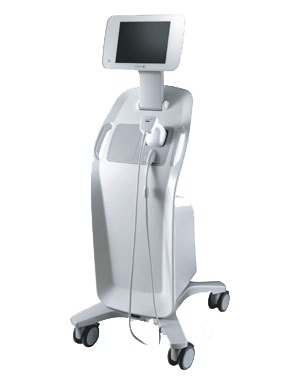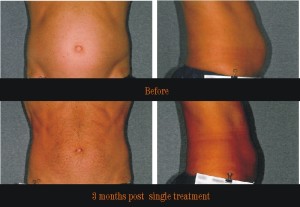How does this differ from Accent XL? I understood Accent XL could be used for body contouring.
The first difference is the depth of the treatment zone. Accent XL Bipolar Radiofrequency targets the middle layer of the skin (the dermis), not the fatty layer, triggering collagen synthesis which tightens the skin. Accent XL is complimentary to Liposonix, as with significant fat reduction some looseness of the overlying skin might occur in patients with poor skin elasticity, which can be greatly improved with Accent XL bipolar treatments. Accent XL Unipolar Radiofrequency targets the fat cells immediately below the dermis (at a depth of 0.3 cms), the diffuse heating of this layer results in shrinkage of the corresponding fat cells in this zone. Repeated sessions of Accent XL are required to achieve a slimming effect.
The second difference is that radiofrequency does not result in a destruction of fat cells. In fact, Accent XL Unipolar treatments are best used for their remodelling effect on the collagen contained in the fat layer, which results in a smoothing of lumpy fat – see Cellulite
What happens to the fat cells after a Liposonix treatment?
Following the destruction of targeted fat cells, macrophages (white blood cells) migrate into the treatment zone to “mop up” the damaged tissue, much like damaged tissue after a wound. That is why there is swelling in the treatment zone, it is a type of inflammatory reaction. The actual fat is carried to the liver, where it is broken down and excreted through bile. Studies have shown there is no dramatic elevation in blood lipids following treatment, the process of disposal is gradual, over several weeks. If you think of the ablated layer of fat as the filling in a sandwich, once the filling is removed, the slices of bread then contract together, resulting in a shrinking effect of the treatment zone.
Does a Liposonix treatment hurt?
Treatments can be done with different energy settings; a total of 180 joules is delivered to each treatment site; this can be accomplished as 3 passes of 60 joules, 4 passes of 45 joules, or 5 passes of 30 Joules; the higher the joules, the more intense the treatment; treating at a lower setting increases the overall treatment time and uses more pulses, resulting in a more costly treatment. A prescription for pain management can be given, which would be taken an hour beforehand, a mild sedative, hence the patient would not be permitted to drive home following the treatment. With proper medication, treatments are well tolerated.
Is there pain following a Liposonix treatment?
There is no significant pain afterwards. One can expect some bruising and/or swelling in the treatment area. We recommend wearing loose fitting comfortable clothing in the week following the procedure, some people prefer to go with compressive garments, either approach is acceptable. Unlike liposuction, where tissue is manually removed, leaving a gap between layers and the possibility of bleeding, Liposonix approach is a much gentler, a more gradual process, with adipose tissue destruction occurring at a microscopic level- so the use of compression garments is entirely the patient’s choice.
In the weeks following treatment, you may experience a tightening or tingling sensation, as the body heals itself and the cellular layers knit together.
Do ultrasound treatments in hospitals or physiotherapy clinics damage fatty tissue? What about ultrasound treatments being offered at various spas, how is that different from Liposonix treatments?
3 differences – frequency, intensity and focus (targeting). Therapeutic or diagnostic ultrasound are low intensity and therefore not damaging to tissue; an exception is lithotripsy, where high intensity focused acoustic waves are used to shatter kidney stones into smaller particles that can be passed through the ureters. The ultrasound beams in the Liposonix system pass through the skin without damaging it, while the convergence of the beams at a preset depth results in a very localised rise in temperature thereby destroying the fat cells. The computerised pattern traced out by the convergent beams avoids irregular cavitation in the fat layer, thus yielding predictable consistent results with an excellent safety profile.
 THOSE LAST FEW INCHES
THOSE LAST FEW INCHES
